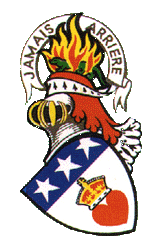|
During the Wars of Independence
(1296 - 1342) the castle changed hands four times. Robert the Bruce was so
impressed with how easily it was taken, he ordered the demolition of all
fortifications after he had won it back from the English in 1314. Edward III of
England built a new castle in 1335 but held it only until 1341 when Sir
William Douglas and his men pretending to be merchants entered the castle by
storm, decapitating most of the garrison and throwing their bodies over the
castle walls.
the Castle of Edinburgh was re-captured from them through an
ingenious stratagem, planned by William Bullock, a priest, who had been captain
of Cupar Castle for Baliol, “and was a man very brave and faithful to the Scots,
and of great use to them,” according to Buchanan.
Posing as a French ship's Captain, William Bullock, one of
Douglas' band, gained admittance to the castle and offered the contents of
"his ship" for sale to the English garrison. When the English agreed
to buy the cargo of food and wine, Bullock arranged for it to be delivered the
following morning. As dawn broke the carts bearing the "cargo" arrived
at the castle gate. The portcullis was lifted and the carts began entering the
castle. As the first cart passed under the raised portcullis, the cart driver
upset it so that the gate could not be lowered. The other cart drivers attacked
the gate guards and gave the bugle call which signalled Douglas and his troops.
The English were defeated and the castle would remain in Scottish hands until
the Union of the Crowns in 1603.
But miserable was the fate of Bullock. By order of a Sir David Berkeley he was
thrown into the castle of Lochindorb, in Morayshire, and deliberately starved to
death. On this a Scottish historian remarks, “It is an ancient saying, that
neither the powerful, nor the valiant, nor the wise, long flourish in Scotland,
since envy obtaineth the mastery of them all.”
See also:
• Edinburgh Castle
|


